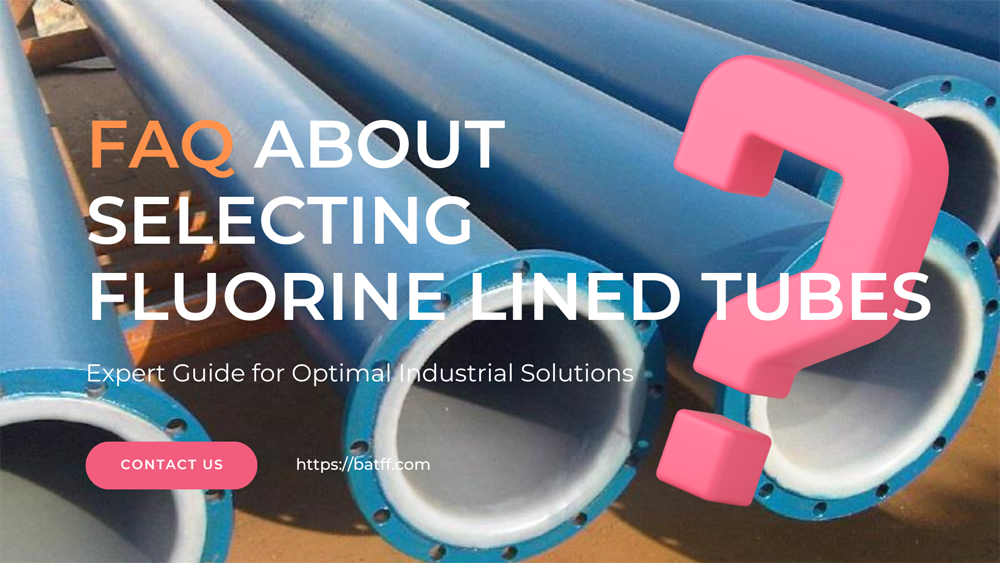
Fluorine lined tubes are an essential component in industries that require robust and reliable piping solutions. Their unique properties make them suitable for handling aggressive chemicals, high temperatures, and high-pressure conditions. Selecting the right fluorine lined tubes is crucial for ensuring the efficiency, safety, and longevity of your systems. This article addresses frequently asked questions to guide you in making an informed decision.
Fluorine lined tubes are pipes that have an internal lining made from fluoropolymers such as PTFE (polytetrafluoroethylene), FEP (fluorinated ethylene propylene), and PFA (perfluoroalkoxy alkane). These materials provide exceptional chemical resistance, low friction, and high-temperature stability. Fluorine lined tubes are used in applications where traditional materials like steel or rubber would fail due to corrosion or chemical attack.
Fluorine lined tubes are made using various fluoropolymers, each offering distinct properties:
PTFE (Polytetrafluoroethylene): Known for its non-stick properties and high chemical resistance, PTFE can handle a wide range of temperatures (-200°C to +260°C). It is ideal for aggressive chemical environments.
FEP (Fluorinated Ethylene Propylene): FEP offers similar chemical resistance to PTFE but with improved flexibility. It operates effectively within a temperature range of -200°C to +205°C.
PFA (Perfluoroalkoxy Alkane): PFA combines the chemical resistance of PTFE with the ease of processing of FEP, making it suitable for high-purity applications. It can withstand temperatures from -200°C to +260°C.
Selecting the appropriate fluoropolymer depends on the specific requirements of your application, such as temperature range, chemical compatibility, and mechanical stress.
Chemical compatibility is critical when selecting fluorine lined tubes. Ensuring that the tube material can withstand the chemicals it will contact prevents degradation and potential failure. Here are steps to determine chemical compatibility:
Identify Chemicals: List all chemicals that will flow through the tube, including any cleaning agents.
Consult Compatibility Charts: Most manufacturers provide chemical compatibility charts. Compare the chemicals with the recommended fluoropolymer materials.
Conduct Tests: For critical applications, perform compatibility testing by exposing sample materials to the chemicals under actual operating conditions.
Manufacturer Consultation: Engage with the tube manufacturer for expert advice, especially if your application involves complex chemical mixtures.
Fluorine lined tubes are designed to handle extreme temperature and pressure conditions. Here’s an overview:
Temperature Tolerance:
PTFE: -200°C to +260°C
FEP: -200°C to +205°C
PFA: -200°C to +260°C
Pressure Tolerance: The pressure rating of fluorine lined tubes depends on their wall thickness and diameter. Generally, they can handle pressures up to 150 PSI, but specific ratings should be confirmed with the manufacturer based on your requirements.
Operating conditions such as temperature fluctuations and the presence of abrasive particles can affect these limits. It is essential to consider these factors during selection.
Choosing the correct size and dimensions involves considering both the inner diameter (ID) and outer diameter (OD) of the tube, as well as the wall thickness. Here’s a step-by-step guide:
Determine Flow Requirements: Calculate the required flow rate and select a tube with an appropriate ID to meet this demand without causing excessive pressure drop.
Check Pressure Ratings: Ensure that the selected tube has a wall thickness that can withstand the operating pressure.
Consider Space Constraints: Evaluate the OD to ensure the tube fits within the available space and can be connected to existing fittings and equipment.
Customization: For unique applications, customized sizes may be necessary. Work with manufacturers to create bespoke solutions.
Cost considerations involve both initial investment and long-term savings. Here are key factors:
Initial Cost: Fluorine lined tubes are generally more expensive than traditional materials due to the cost of fluoropolymers and manufacturing processes.
Long-term Savings: Despite the higher initial cost, fluorine lined tubes often provide long-term savings due to their durability and reduced maintenance needs.
Factors Influencing Cost:
Material choice (PTFE, FEP, PFA)
Size and thickness
Customization and special requirements
A cost-benefit analysis should include the tube's lifespan, maintenance costs, and potential downtime due to failures.
Proper installation is crucial for maximizing the performance and lifespan of fluorine lined tubes. Here are some best practices:
Inspect Before Installation: Check for any damage or defects in the tubes.
Clean Connections: Ensure that all connections and fittings are clean and free from debris.
Follow Manufacturer Guidelines: Adhere to the installation instructions provided by the manufacturer, including torque specifications for fittings.
Avoid Excessive Bending: Fluorine lined tubes are flexible but should not be bent excessively to prevent kinking.
Support and Secure: Properly support the tubes to prevent sagging and secure them to avoid movement and vibration.
Regular maintenance and inspection are key to ensuring the longevity and reliability of fluorine lined tubes. Here are some tips:
Routine Inspections: Conduct visual inspections regularly to check for signs of wear, corrosion, or damage.
Pressure Testing: Periodically perform pressure tests to ensure the integrity of the tubes.
Cleaning: Clean the tubes using appropriate methods and chemicals that do not degrade the fluoropolymer lining.
Monitor for Leaks: Install monitoring systems to detect leaks early and take corrective action immediately.
Fluorine lined tubes are used across various industries due to their versatility and durability:
Chemical Processing: Handling aggressive chemicals and corrosive substances.
Pharmaceutical Manufacturing: Ensuring purity and avoiding contamination.
Food and Beverage Industry: Providing non-reactive and sanitary piping solutions.
Oil and Gas Industry: Managing harsh environments and corrosive fluids.
Fluorine lined tubes offer several advantages over other corrosion-resistant materials:
Chemical Resistance: Superior to many metals and alloys.
Temperature Range: Wider operating temperature range compared to most plastics.
Non-stick Properties: Unique to fluoropolymers, reducing blockages and facilitating cleaning.
However, they may have lower mechanical strength compared to metals and can be more expensive initially.
Fluorine lined tubes contribute to environmental sustainability and safety in several ways:
Reduced Chemical Leaks: High chemical resistance minimizes the risk of leaks and spills.
Longevity: Long service life reduces the need for frequent replacements, minimizing waste.
Safety: Non-reactive and non-toxic properties enhance safety in handling hazardous substances.
Compliance: Many fluoropolymers comply with stringent environmental and safety regulations.
Selecting the right fluorine lined tubes involves understanding the specific requirements of your application, including chemical compatibility, temperature and pressure conditions, and cost considerations. By addressing these frequently asked questions, this guide aims to provide you with the knowledge needed to make an informed decision, ensuring the efficiency, safety, and longevity of your systems.
Feel free to leave your message on our board. If you're looking to inquire about prices or place an order, this is the right place! Let us know the details of your needs, and our team will get back to you with a personalized quote as quickly as possible. We're here to ensure your experience is seamless and satisfactory. Share your requirements or ask any questions you might have - we're eager to assist and look forward to doing business with you!
Name:Tim
Phone:+86-15716151880
Email:[email protected]
Company:BEANT
Address:No. 28, Luoshen Road, Luoshe Town, Huishan District, Wuxi City, Jiangsu Province
